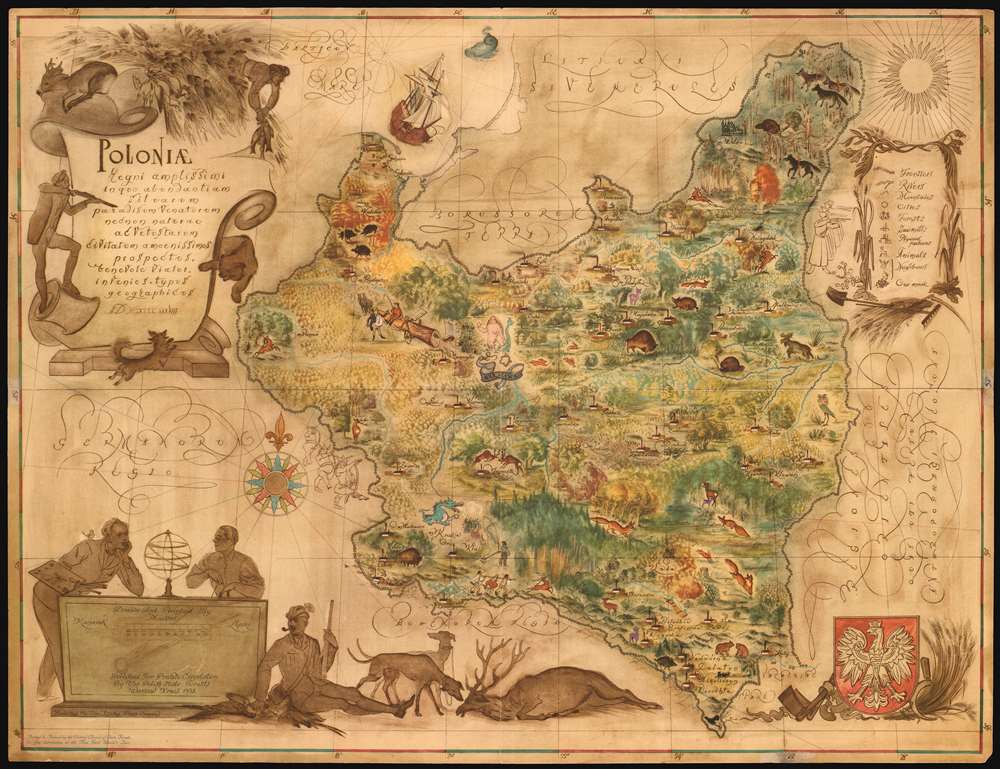Digital Image: 1938 Kanarek and Lipski Pictorial Nature Map of Poland
PolandForestry-kanareklipski-1938_d
Title
1938 (dated) 14 x 18 in (35.56 x 45.72 cm) 1 : 2000000
Description
FOR THE ORIGINAL ANTIQUE MAP, WITH HISTORICAL ANALYSIS, CLICK HERE.
Digital Map Information
Geographicus maintains an archive of high-resolution rare map scans. We scan our maps at 300 DPI or higher, with newer images being 600 DPI, (either TIFF or JPEG, depending on when the scan was done) which is most cases in suitable for enlargement and printing.
Delivery
Once you purchase our digital scan service, you will receive a download link via email - usually within seconds. Digital orders are delivered as ZIP files, an industry standard file compression protocol that any computer should be able to unpack. Some of our files are very large, and can take some time to download. Most files are saved into your computer's 'Downloads' folder. All delivery is electronic. No physical product is shipped.
Credit and Scope of Use
You can use your digial image any way you want! Our digital images are unrestricted by copyright and can be used, modified, and published freely. The textual description that accompanies the original antique map is not included in the sale of digital images and remains protected by copyright. That said, we put significant care and effort into scanning and editing these maps, and we’d appreciate a credit when possible. Should you wish to credit us, please use the following credit line:
Courtesy of Geographicus Rare Antique Maps (http://www.geographicus.com).
How Large Can I Print?
In general, at 300 DPI, you should at least be able to double the size of the actual image, more so with our 600 DPI images. So, if the original was 10 x 12 inches, you can print at 20 x 24 inches, without quality loss. If your display requirements can accommodate some loss in image quality, you can make it even larger. That being said, no quality of scan will allow you to blow up at 10 x 12 inch map to wall size without significant quality loss. For more information, it is best consult a printer or reprographics specialist.
Refunds
If the high resolution image you ordered is unavailable, we will fully refund your purchase. Otherwise, digital images scans are a service, not a tangible product, and cannot be returned or refunded once the download link is used.
Cartographer S
Eliasz Kanarek (June 21, 1902 - May 1969) was a Polish painter and noted portrait artist. Kanarek served in the Polish army from 1919 - 1920 and in 1923 began attending the Warsaw School of Fine Arts. Kanarak was a member of the Brotherhood of St. Łukasz and exhibited his work with this group. He worked as a cartoonist for the weekly 'Szpilki' from 1935 - 1938. He also participated in the Venetian Biennale in 1934 and exhibited his work at the Carnegie Institute in Pittsburgh in 1937. In 1938, he and six other members of the Brotherhood of St. Łukasz were commissioned to paint seven historical paintings to be displayed in the Polish pavilion at the New York World's Fair in 1939. In March 1939, Kanarak and another artist, Bolesław Cybis, sailed for New York with the paintings for the World's Fair. After the outbreak of World War II later that year, Kanarek remained in the United States in exile. Kanarek moved to Washington, D.C. and took up portrait painting, and among his subjects was General Marshall. The paintings also stayed in the United States and eventually went to Le Moyne College in Syracuse, New York. Kanarek became a naturalized American citizen on May 14, 1948 in Los Angeles, California, where he established a studio. More by this mapmaker...
Tadeusz Lipski (June 30, 1905 - April 7, 1987) was a Polish illustrator, painter, and graphic artist. He studied at the Graphic Arts Department of the Academy of Fine Arts in Warsaw. He found himself in France at the outbreak of World War II, and eventually made his way to England. After the war was over, he emigrated to the United States, and gained American citizenship on December 10, 1956. He lived in New York for years, where he exhibited his work in galleries. At some point he moved to Passaic, New Jersey, where he spent the rest of his life. Learn More...

